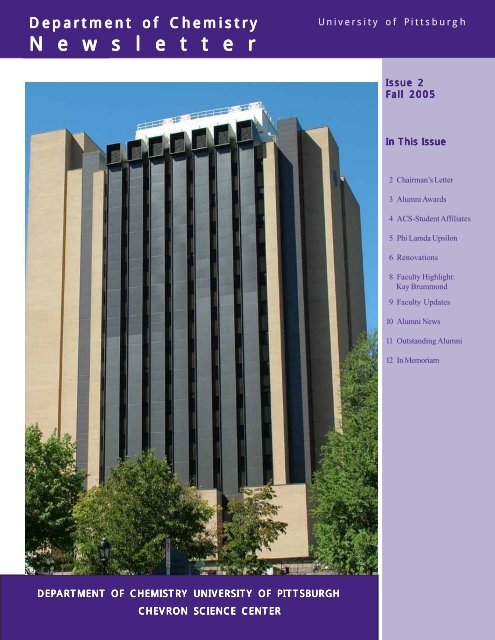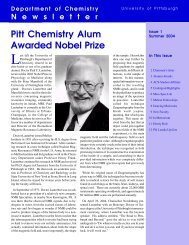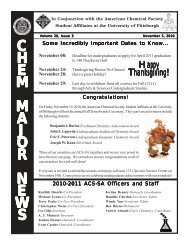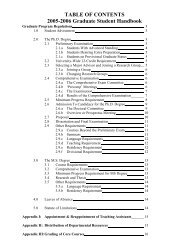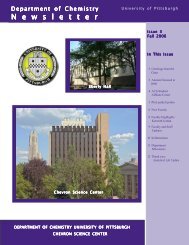N e w s l e t t e r - Department of Chemistry - University of Pittsburgh
N e w s l e t t e r - Department of Chemistry - University of Pittsburgh
N e w s l e t t e r - Department of Chemistry - University of Pittsburgh
You also want an ePaper? Increase the reach of your titles
YUMPU automatically turns print PDFs into web optimized ePapers that Google loves.
<strong>Department</strong> <strong>of</strong> <strong>Chemistry</strong><br />
N e w s l e t t e r<br />
<strong>University</strong> <strong>of</strong> <strong>Pittsburgh</strong><br />
Issue 2<br />
Fall 2005<br />
In This Issue<br />
2 Chairman’s Letter<br />
3 Alumni Awards<br />
4 ACS-Student Affiliates<br />
5 Phi Lamda Upsilon<br />
6 Renovations<br />
8 Faculty Highlight:<br />
Kay Brummond<br />
9 Faculty Updates<br />
10 Alumni News<br />
11 Outstanding Alumni<br />
12 In Memoriam<br />
DEPARTMENT OF CHEMISTRY UNIVERSITY OF PITTSBURGH<br />
CHEVRON SCIENCE CENTER<br />
www.chem.pitt.edu<br />
1
<strong>University</strong> <strong>of</strong> <strong>Pittsburgh</strong><br />
<strong>Department</strong> <strong>of</strong> <strong>Chemistry</strong><br />
Greetings from the Chair<br />
2<br />
The <strong>Department</strong> has experienced important<br />
changes during the past year, and I want to update<br />
you. Those with a memory for detail will<br />
see that the Chevron tower (front cover) looks<br />
different, and <strong>of</strong> course I am writing this letter<br />
rather than Ken Jordan. I would like to thank<br />
Ken for his service as the <strong>Department</strong> Chair during<br />
the past three years.<br />
A number <strong>of</strong> staffing and faculty changes have<br />
occurred in the past year. Paul Floreancig has<br />
been promoted to Associate Pr<strong>of</strong>essor with tenure<br />
and Peter Wipf was promoted to <strong>University</strong><br />
Pr<strong>of</strong>essor. Gilbert Walker took a position at the<br />
<strong>University</strong> <strong>of</strong> Toronto; however, he maintains active<br />
collaborations in the <strong>Department</strong>. Dr. Amy<br />
Beisler (PhD 2003) left her position as lecturer<br />
and is working at Bettis Laboratory. Three new<br />
faculty arrived in the <strong>Department</strong> this fall - Drs.<br />
Megan Spence, Alex Star and Yury Skorik (see<br />
page 9). We are very excited about the new ideas<br />
and talents they bring. We welcomed Kris Takach,<br />
our computer specialist, in March, 2005. Dr. Fu<br />
Tyan Lin, our NMR director, retired after 25 years,<br />
and his replacement, Dr. Damodaran Krishnan<br />
Achary, arrived October 1. Dr. Kasi Somayajula<br />
resigned to take a position at Coca-Cola, and Dr.<br />
John Williams (PhD 2002) became the Director<br />
<strong>of</strong> the Mass Spectrometry facility on October 1.<br />
Brian Strohmeier (PhD 1984) resigned from the<br />
assistant chair position, and our new Assistant<br />
Chair is Mr. William T. Valenta. We wish our<br />
former colleagues good fortune in their new<br />
endeavours, and give a hearty welcome to our<br />
new colleagues.<br />
Major upgrades to Chevron’s climate and ventilation<br />
systems have been performed during the<br />
past year at a cost <strong>of</strong> $6M. We now have a two<br />
story building on the ro<strong>of</strong> <strong>of</strong> the tower (see pages<br />
6,7), which houses the fans for intake and exhaust<br />
air. In addition, two additional ventilation<br />
shafts appear on the front <strong>of</strong> the building. This<br />
represents the first phase <strong>of</strong> an effort to bring<br />
Chevron (a 30 year old building) up to modern<br />
standards.<br />
Research in the <strong>Department</strong> continues to grow<br />
in strength. This past year we had 136 publications<br />
by the faculty and over $10M in research<br />
support. The collaborative nature <strong>of</strong> chemistry<br />
research becomes more important each year. Faculty<br />
are involved in eight different collaborative<br />
grants.<br />
The research growth in the <strong>Department</strong> is<br />
strongly linked with the quality <strong>of</strong> the graduate<br />
students, and the graduate class this year has a<br />
size <strong>of</strong> 29. During this past year, the department<br />
had 57 seminars. Notable events were Pr<strong>of</strong>. Y. T.<br />
Lee (Nobel Prize 1996) as the Kaufman Lecturer,<br />
and a special Phillips symposium comprised <strong>of</strong><br />
Pr<strong>of</strong> J. M. Ramsey (UNC), Pr<strong>of</strong>. D. Nocera<br />
(MIT), Pr<strong>of</strong>. D. Boger (Scripps Research Institute),<br />
and Pr<strong>of</strong>. M. Karplus (Harvard). The department<br />
awarded 15 PhDs and 6 Masters degrees<br />
during the past year. The graduate students<br />
won a number <strong>of</strong> competitive awards and<br />
fellowships, including 3 Mellon Fellowships and<br />
2 Warga Fellowships.<br />
The undergraduate program in <strong>Chemistry</strong> remains<br />
strong. During this past year we graduated<br />
48 <strong>Chemistry</strong> majors with bachelor’s degrees.<br />
These students won a number <strong>of</strong> external awards,<br />
including The American Institute <strong>of</strong> Chemists<br />
Award, The SACP College Award, and The Merck<br />
Award. The ACS-Student Affiliates received national<br />
recognition for the fifteenth consecutive<br />
year; its “outstanding chapter,” recognition was<br />
awarded to only twenty-six out <strong>of</strong> 900 student<br />
affiliates chapters.<br />
A pr<strong>of</strong>ound measure <strong>of</strong> the <strong>Department</strong>’s<br />
strength and educational quality is the success <strong>of</strong><br />
its alumni. This past year we honored four <strong>of</strong><br />
our distinguished alumni - D. Kleid, M. Simon, L.<br />
D. McKeever, and G. S. Pinkus. The department<br />
continues to grow in quality and prestige by the<br />
accomplishments and support <strong>of</strong> its alumni (see<br />
page 3). We encourage you to send us information<br />
about activities that you would like to share<br />
with friends, teachers, and contemporaries in the<br />
<strong>Chemistry</strong> department.<br />
I hope you enjoy the Newsletter and will visit<br />
the Web site to learn more about events in the<br />
<strong>Department</strong>.<br />
www.chem.pitt.edu
<strong>Department</strong> <strong>of</strong> <strong>Chemistry</strong><br />
<strong>University</strong> <strong>of</strong> <strong>Pittsburgh</strong><br />
Alumni Honored in 2004<br />
Dennis Kleid received his Ph. D. degree<br />
in <strong>Chemistry</strong> in 1972 under the guidance <strong>of</strong><br />
Toby Chapman. After postdoctoral appointments<br />
with H. G. Khorana at MIT and Mark<br />
Ptashne at Harvard, he took a position in the<br />
Life Sciences Division at the Stanford Research<br />
Institute. Dr. Kleid is a pioneer<br />
whose contributions have<br />
proved to be vital for the field<br />
<strong>of</strong> genetic engineering and in<br />
furthering the successful treatment<br />
<strong>of</strong> disease. He is an excellent<br />
example <strong>of</strong> how the<br />
<strong>Chemistry</strong> <strong>Department</strong> prepares<br />
students to transform the present and discover<br />
the future.<br />
Geraldine Sowinski Pinkus received<br />
her B.S. in <strong>Chemistry</strong> (summa cum laude) in<br />
1961 from the <strong>University</strong> <strong>of</strong> <strong>Pittsburgh</strong>. Dr.<br />
Pinkus continued her education at Pitt completing<br />
a medical degree. Her residency began in<br />
pathology at the <strong>University</strong> <strong>of</strong><br />
<strong>Pittsburgh</strong> and she completed<br />
this training at Peter Bent<br />
Brigham Hospital (now the<br />
Brigham & Women’s Hospital)<br />
in Boston where she became<br />
chief resident. After accepting<br />
a staff position at that<br />
hospital, she eventually became the Director <strong>of</strong><br />
the Hematopathology Division and Director <strong>of</strong><br />
the Hematopathology Service at the Dana<br />
Farber Cancer Institute. Dr. Pinkus is also Pr<strong>of</strong>essor<br />
<strong>of</strong> Pathology at the Harvard Medical<br />
School. She has had an exemplary career as a<br />
scientist and educator and her laboratory became<br />
a pioneer in immunohistochemistry.<br />
L. Dennis McKeever received his<br />
B. S. in <strong>Chemistry</strong>, <strong>University</strong> <strong>of</strong> <strong>Pittsburgh</strong>,<br />
in 1962. He received his<br />
Ph. D. in Physical <strong>Chemistry</strong><br />
at the <strong>University</strong> <strong>of</strong><br />
California, Irvine. Dr.<br />
McKeever has a fortyyear<br />
record <strong>of</strong> significant<br />
achievements in senior<br />
technical and business<br />
management. Today he is Chairman <strong>of</strong> the<br />
Board <strong>of</strong> SYM Financial Corporation,<br />
which manages $600,000,000 in assets, and<br />
he is President <strong>of</strong> McKeever Ventures, providing<br />
broad-based strategic advisory services<br />
to a diverse client base including Exxon<br />
Chemical, Shell Chemical, and the American<br />
Plastics Council.<br />
J. Matthew Simon received his Ph.D.<br />
in <strong>Chemistry</strong> from the <strong>University</strong> <strong>of</strong> <strong>Pittsburgh</strong><br />
in 1969 under the direction <strong>of</strong> Pr<strong>of</strong>essor<br />
Johannes Coetzee. Dr. Simon joined<br />
the faculty at Point Park College in 1969.<br />
While a faculty member, he served as the<br />
Chairman <strong>of</strong> the <strong>Department</strong> <strong>of</strong> Natural Science<br />
and Engineering Technology and the<br />
Director <strong>of</strong> Studies<br />
at the European<br />
Campus <strong>of</strong> Point<br />
Park College in<br />
Switzerland. He<br />
served as the President<br />
<strong>of</strong> Point Park<br />
College from 1986<br />
to 1995. He is now<br />
a Distinguished Service Pr<strong>of</strong>essor at Point<br />
Park College and Adjunct Pr<strong>of</strong>essor in the<br />
School <strong>of</strong> Education at the <strong>University</strong> <strong>of</strong><br />
<strong>Pittsburgh</strong>.<br />
CALL<br />
FOR<br />
NOMINATIONS<br />
The <strong>Department</strong> is soliciting<br />
nominations for<br />
<strong>Chemistry</strong> <strong>Department</strong><br />
Alumni Awards. Nominees<br />
should have a<br />
bachelor’s, master’s or<br />
doctoral degree from the<br />
<strong>Department</strong>. The basis<br />
for the nomination can<br />
be excellence in research,<br />
teaching, management,<br />
or volunteer<br />
efforts. Nominations<br />
should include:<br />
1. Your nominating<br />
letter<br />
2. At least one but no<br />
more than three seconding<br />
letters<br />
3. A CV for the nominee<br />
4. Contact information<br />
for the nominee<br />
Please see<br />
http://<br />
www.chem.pitt.edu/<br />
alumni/home.asp<br />
for more information<br />
Nominations should be<br />
posted by<br />
December 1, 2005<br />
to:<br />
Assistant Chair<br />
Dept. <strong>of</strong> <strong>Chemistry</strong><br />
<strong>University</strong> <strong>of</strong> <strong>Pittsburgh</strong><br />
<strong>Pittsburgh</strong> PA 15260<br />
valenta@pitt.edu<br />
www.chem.pitt.edu<br />
3
<strong>University</strong> <strong>of</strong> <strong>Pittsburgh</strong><br />
<strong>Department</strong> <strong>of</strong> <strong>Chemistry</strong><br />
ACS-Student Affiliate Corner<br />
2005<br />
Undergraduate<br />
Senior Awards<br />
The Merck Award<br />
Anthony P. Petruso<br />
Ryan N. Schroeder<br />
The American Institute <strong>of</strong><br />
Chemists Award<br />
Joan M. Fletcher<br />
The SACP College Award<br />
Sarah C. Bell<br />
The Mary Louise Theodore<br />
Prize<br />
Ryan J. Graziani<br />
Jeremy M. Higgins<br />
Andrea S. Matla<br />
Kevin M. Noone<br />
April M. Weir<br />
The Phillips Medal<br />
James M. Apgar<br />
The American Chemical Society-Student Affiliates<br />
Chapter has received national recognition<br />
for the fifteenth consecutive year. In 2004-<br />
2005 the group was recognized as an “outstanding<br />
chapter.” This designation is the highest recognition<br />
and was awarded to only twenty-six<br />
out <strong>of</strong> 900 student affiliates chapters. Community<br />
service is an integral part <strong>of</strong> our awardwinning<br />
chapter. By promoting and maintaining<br />
many outreach programs, we expose students<br />
in the <strong>Pittsburgh</strong> area to interactive chemistry<br />
demonstrations and experiments so that they<br />
can learn more about this diverse and intriguing<br />
field <strong>of</strong> science.<br />
Curiosity is one <strong>of</strong> the most important characteristics<br />
that a scientist can possess and<br />
through our outreach efforts in local elementary<br />
and high schools, the ACS-SA members<br />
attempt to keep the spark <strong>of</strong> curiosity alive in<br />
the future scientists living in the <strong>Pittsburgh</strong> area.<br />
Armed with demonstrations involving gas evolution,<br />
color changes and explosions that <strong>of</strong>ten<br />
literally move students out <strong>of</strong> their seats, our<br />
members explain chemical phenomena and answer<br />
the questions <strong>of</strong> curious students .<br />
Our Saturday Science and Honors Organic<br />
Programs, co-sponsored by Investing Now and<br />
the American Chemical Society Education<br />
Group, allow members to have one-on-one<br />
contact with local high school students who are<br />
interested in science. These interactions afford<br />
our members the opportunity to serve as mentors<br />
and encourage students’ pursuit <strong>of</strong> knowledge<br />
in the areas <strong>of</strong> synthetic and analytical<br />
chemistry. Through a variety <strong>of</strong> hands-on demonstrations<br />
and interactive laboratory experiments,<br />
the students are exposed to areas <strong>of</strong><br />
chemistry, such as polymer design, that are not<br />
typically covered in high school curricula while<br />
witnessing firsthand the life <strong>of</strong> a scientist working<br />
in a chemistry laboratory.<br />
Our members also travel to different sites in<br />
the greater <strong>Pittsburgh</strong> area to enhance elementary<br />
and middle school aged students’ interest<br />
in science. We have participated in after-school<br />
programs in order to facilitate science activities<br />
with students and recently, our members traveled<br />
to the Carnegie Science Center to perform<br />
demonstrations addressing this year’s National<br />
<strong>Chemistry</strong> Week theme “Health and<br />
Wellness.” Members used demonstrations involving<br />
pH to illustrate the importance <strong>of</strong> maintaining<br />
homeostasis in the human body. Students<br />
learned the chemical basis <strong>of</strong> the ways in<br />
which carbon dioxide passes through their<br />
bloodstream and why they take an antacid to<br />
settle an upset stomach.<br />
We are currently in the process <strong>of</strong> organizing<br />
a science fair that will bring various undergraduate<br />
organizations together to share their enthusiasm<br />
for chemistry, biology, physics, and other<br />
science-related areas, as well as the practical<br />
applications <strong>of</strong> scientific knowledge in everyday<br />
activities with local middle school students.<br />
By sharing our enthusiasm for science with<br />
younger students, we hope to give back to the<br />
<strong>Pittsburgh</strong> community that has fostered a love<br />
for science in each <strong>of</strong> us.<br />
To learn more about our organization and its<br />
outreach efforts, please visit our website at http:/<br />
/www.chem.pitt.edu/acs-sa/.<br />
2005 <strong>Chemistry</strong> Graduates<br />
20<br />
4<br />
www.chem.pitt.edu
<strong>Department</strong> <strong>of</strong> <strong>Chemistry</strong><br />
<strong>University</strong> <strong>of</strong> <strong>Pittsburgh</strong><br />
Phi Lambda Upsilon (PLU)<br />
Phi Lambda Upsilon (PLU) is a National Honorary<br />
<strong>Chemistry</strong> Society founded with the purpose<br />
<strong>of</strong> promoting high scholarship and original<br />
investigation in all branches <strong>of</strong> pure and applied<br />
chemistry. The <strong>University</strong> <strong>of</strong> <strong>Pittsburgh</strong> represents<br />
the Xi chapter <strong>of</strong> PLU with its foundation<br />
in 1917. Our current roster consists <strong>of</strong> 84 graduate<br />
students and 19 faculty members, 21 <strong>of</strong><br />
whom were initiated in 2005.<br />
During the 2004-2005 year, PLU organized<br />
a number <strong>of</strong> social and academic events for the<br />
<strong>Chemistry</strong> <strong>Department</strong> including: the annual new<br />
graduate student picnic in August, the annual Holiday<br />
party in December, and student poster sessions<br />
among others. However, the most significant<br />
event <strong>of</strong> the 2004-2005 year was the 50 th<br />
Annual Francis Clifford Phillips Lecture Symposium<br />
held in May 2005. The Phillips Lecture<br />
is the longest running chemistry lecture series organized<br />
by graduate students in the country! Our<br />
invited speakers were drawn from the four traditional<br />
areas <strong>of</strong> chemistry – Dr. J. Michael<br />
Ramsay <strong>of</strong> the <strong>University</strong> <strong>of</strong> North Carolina representing<br />
Analytical <strong>Chemistry</strong>, Dr. Daniel<br />
Nocera <strong>of</strong> the Massachusetts Institute <strong>of</strong> Tech-<br />
nology representing Inorganic <strong>Chemistry</strong>, Dr.<br />
Dale Boger <strong>of</strong> Scripps Research Institute representing<br />
Organic <strong>Chemistry</strong>, and Dr. Martin<br />
Karplus <strong>of</strong> Harvard <strong>University</strong> representing<br />
Physical <strong>Chemistry</strong>. The Symposium stretched<br />
over three days and also included a dinner and<br />
poster session. We are happy to report that<br />
the Symposium was a huge success, and we<br />
look forward to planning the 51 st Phillips Lecture.<br />
Keeping with the tradition <strong>of</strong> previous years,<br />
in the 2005-2006 year we are again planning<br />
events welcoming the incoming graduate students<br />
and other various academic and social<br />
events for the department. Our new <strong>of</strong>ficers<br />
for 2005-2006 are:<br />
President – Amanda Garner<br />
(Third Year, research with Pr<strong>of</strong>. K. Koide)<br />
Vice-President – Brian Albert<br />
(Fourth Year, research with Pr<strong>of</strong>. K. Koide)<br />
Treasurer – Bhavya Sharma<br />
(Third Year, research with Pr<strong>of</strong>. S. Asher)<br />
Secretary-Jeananne Singletary<br />
(Second Year, research with Pr<strong>of</strong>. K. Brummond)<br />
2005-06<br />
Mellon Fellowship<br />
Awardees<br />
Min Liu<br />
Branko Mitasev<br />
Jian Zhang<br />
2004-05<br />
Warga Fellowship<br />
Awardees<br />
Lauren Ashe Fellows<br />
Laura Belasco<br />
Justin Bohn<br />
Matthew Davis<br />
Suzanne Gardner<br />
04 <strong>Chemistry</strong><br />
Heather Gibney<br />
Darrick Gross<br />
Graduates<br />
Todd Haas<br />
Alex Harmatuck<br />
Adam Hoye<br />
Benjamin Kabagambe<br />
Wendy Lampart<br />
Tiffany Lowery<br />
2004-2005 Graduate Student Fellows<br />
Megan Macala<br />
Christopher Morgan<br />
Benjamin Norris<br />
David Oxley<br />
William Parker<br />
Wesley Rice<br />
Jeananne Singletary<br />
Jennifer Smotryski<br />
Jessica Thomas<br />
Provost’s Award<br />
Jason Lewis<br />
Patrick Rodgers<br />
Sunoco Fellowship<br />
Kristi O’Neal<br />
Bayer Fellow<br />
Hyung Hoon Jung<br />
Frederick Kaufmann Fellow<br />
Philip Morgan<br />
Graduate Excellence Fellows<br />
Jamie McCabe<br />
Soraya Pornsuwan<br />
Hongjun Yue<br />
Jian Zhang<br />
Yifat Guy<br />
Jennifer Loyer-Drew<br />
www.chem.pitt.edu<br />
5
<strong>University</strong> <strong>of</strong> <strong>Pittsburgh</strong><br />
<strong>Department</strong> <strong>of</strong> <strong>Chemistry</strong><br />
Chevron Science Center and Eberly Hall<br />
Changing for the Better – Inside and Out!<br />
6<br />
If you have not seen Chevron Science Center<br />
recently, be sure to take a closer look the<br />
next time you are in Oakland. A major construction<br />
project that began last August at the<br />
<strong>Chemistry</strong> <strong>Department</strong> has just been completed.<br />
The $6.2 million endeavor, funded by the Pennsylvania<br />
<strong>Department</strong> <strong>of</strong> General Services<br />
(DGS), lasted 13 months and involved a total<br />
renovation and upgrade <strong>of</strong> the building’s 30-<br />
year-old heating, ventilation, and air conditioning<br />
(HVAC) systems. The planning for this<br />
major project began more than 2 years ago with<br />
a budget <strong>of</strong> about $5 million, but work changes<br />
during the design stage and rising steel prices<br />
pushed the final budget up to the $6.2 million<br />
figure.<br />
The new HVAC system provides increased<br />
exhaust capacity for existing chemical fume<br />
hoods and a reserve capacity for an additional<br />
40 hoods in the future. This overdue upgrade<br />
will go a long way toward improving the operation<br />
<strong>of</strong> the existing 280 fume hoods as well<br />
as the environmental control in the building. Our<br />
neighbors in the Oakland area will appreciate<br />
that the exhaust noise level associated with the<br />
building has been significantly reduced.<br />
The HVAC renovation project involved constructing<br />
a new 2-story air handler unit on top<br />
<strong>of</strong> the existing ro<strong>of</strong> and two new 12-story air<br />
supply shafts on opposite ends <strong>of</strong> the front <strong>of</strong><br />
the building. The existing interior building<br />
ductwork was then connected to the new ro<strong>of</strong>top<br />
unit and supply shafts. The space occupied<br />
by the former fan rooms on the fourth and eleventh<br />
floors in Chevron will eventually become<br />
new laboratory space.<br />
These changes, for the most part, will be rather<br />
subtle to the casual observer on the street. Not<br />
so subtle though was the 20-story crane that<br />
was constructed directly in front <strong>of</strong> the building<br />
on <strong>University</strong> Drive. The crane was erected to<br />
lift large structural steel and other components<br />
onto the ro<strong>of</strong> and it attracted a lot <strong>of</strong> interest<br />
from everyone in the Oakland area. The crane<br />
impacted the many students who enter Chevron<br />
each day since pedestrian traffic into and<br />
out <strong>of</strong> the building had to be redirected as a<br />
safety precaution numerous times over the<br />
course <strong>of</strong> this project.<br />
While the outside <strong>of</strong> Chevron has been changing,<br />
the inside has not been neglected! The Electronics<br />
Shop was recently relocated from its old<br />
home on the 10 th floor to a new, larger, renovated<br />
space on the 3 rd floor <strong>of</strong> Eberly Hall (the<br />
former Alumni Hall). This move provided much<br />
needed space in Chevron for the construction<br />
<strong>of</strong> new organic synthesis laboratories. As part<br />
<strong>of</strong> this $1.3 million project, vacant laboratory<br />
space on the 9 th floor <strong>of</strong> Chevron, which was<br />
freed up when Pr<strong>of</strong>essor Jordan’s research<br />
group relocated to Eberly Hall a few years ago,<br />
was also converted into new organic synthesis<br />
laboratories. Two additional fume hoods were<br />
also added to existing laboratory space for Pr<strong>of</strong>essor<br />
Schafmeister’s research group. All-inall,<br />
this important renovation project added 16<br />
new fume hoods to the <strong>Department</strong> and should<br />
provide ample room for new faculty as well as<br />
expansion <strong>of</strong> current organic research groups.<br />
The final part <strong>of</strong> this project involved the construction<br />
<strong>of</strong> a new conference room in Eberly<br />
Hall that provides an excellent facility for faculty<br />
meetings and thesis defenses.<br />
Stop by the <strong>Department</strong> when you get a<br />
chance to see all <strong>of</strong> these exciting changes<br />
firsthand!<br />
www.chem.pitt.edu
<strong>Department</strong> <strong>of</strong> <strong>Chemistry</strong><br />
<strong>University</strong> <strong>of</strong> <strong>Pittsburgh</strong><br />
www.chem.pitt.edu<br />
7
<strong>University</strong> <strong>of</strong> <strong>Pittsburgh</strong><br />
<strong>Department</strong> <strong>of</strong> <strong>Chemistry</strong><br />
Faculty Highlights: Kay Brummond, Associate Pr<strong>of</strong>essor<br />
Catalytic Decision Points and Reaction Discovery<br />
The ability to put together complex molecules,<br />
like piecing together a puzzle, is a challenging endeavor<br />
since the skills required to accomplish this<br />
are as much artistic as scientific.<br />
My group enjoys thinking about and discovering<br />
new ways to assemble the atoms that complex<br />
molecules are made from. Once a new method<br />
has been identified in the laboratory, experiments<br />
are designed and performed to test and validate<br />
them for their robustness and utility.<br />
We have demonstrated<br />
that transition<br />
metal catalyzed<br />
processes can be intercepted<br />
at various<br />
stages <strong>of</strong> the catalytic<br />
cycle “catalytic<br />
decision<br />
points” to provide<br />
structurally unique<br />
compounds, depending<br />
upon the<br />
point <strong>of</strong> interception.<br />
This divergent<br />
strategy is not typically<br />
exploited in the<br />
chemistry laboratory<br />
but is one that<br />
is adopted by nature<br />
in the assembly <strong>of</strong> secondary metabolites, more<br />
commonly referred to as natural products.<br />
ML n<br />
ML n<br />
ML n<br />
O<br />
M<br />
Ln<br />
The new reactions are then used in our group<br />
to synthesize collections or libraries <strong>of</strong> previously<br />
unknown compounds. Once synthesized, the compounds<br />
are tested for their biological activity by<br />
researchers at the <strong>University</strong> <strong>of</strong> <strong>Pittsburgh</strong> and<br />
across the country. These compounds are designed<br />
on the premise that they may function as<br />
an important biological tool and may someday lead<br />
to the development <strong>of</strong> a new drug for diseases<br />
such as cancer or tuberculosis. The latter part <strong>of</strong><br />
this project is done in collaboration with the <strong>University</strong><br />
<strong>of</strong> <strong>Pittsburgh</strong> Chemical Methods and Library<br />
Development Center (UPCMLD). For more<br />
information see: http://ccc.chem.pitt.edu/.<br />
In addition to preparing entirely new compounds,<br />
we also use the new methods discovered<br />
in our group to synthesize compounds in<br />
which their biological<br />
significance<br />
has already<br />
been established.<br />
The<br />
ML n<br />
goal <strong>of</strong> these efforts<br />
is to provide<br />
faster,<br />
O<br />
more efficient<br />
and innovative<br />
means <strong>of</strong> accessing<br />
these<br />
structures. For<br />
example, these<br />
Catalytic Decision Points<br />
ML n<br />
O<br />
MHLn<br />
MHLn<br />
new methods<br />
have been successfully<br />
applied<br />
to the synthesis<br />
<strong>of</strong> HMAF, a potent<br />
anticancer compound currently in Phase III<br />
clinical trials and 15-deoxy-∆ 12,14 PGJ 2<br />
, a<br />
cyclopentenone prostaglandin that is a natural<br />
ligand for PPAR, a receptor linked to type II diabetes<br />
and obesity and FR901483, a compound possessing<br />
immunosuppressive activity. Ongoing<br />
projects include the synthesis <strong>of</strong> guanacastepene,<br />
isolated recently and shown to exhibit excellent<br />
activity against vancomycin resistant bacteria and<br />
suberosenone, possesses differential cytotoxicity<br />
in human tumor cell-lines.<br />
The students involved with these projects are<br />
uniquely suited to go on and work in the pharmaceutical<br />
industry where they will strive to discover<br />
and develop new drugs.<br />
8<br />
www.chem.pitt.edu
<strong>Department</strong> <strong>of</strong> <strong>Chemistry</strong><br />
<strong>University</strong> <strong>of</strong> <strong>Pittsburgh</strong><br />
Faculty Updates<br />
New Hires<br />
Yury Skorik<br />
Lecturer<br />
Analytical <strong>Chemistry</strong><br />
Megan Spence<br />
Assistant Pr<strong>of</strong>essor<br />
Physical <strong>Chemistry</strong><br />
Alex Star<br />
Assistant Pr<strong>of</strong>essor<br />
Nanoscience<br />
John Williams<br />
Director<br />
Mass Spectrometry<br />
Damodaran<br />
Krishnan Achary<br />
Director<br />
NMR<br />
Faculty Nuggets<br />
Sanford Asher (Pr<strong>of</strong>essor)<br />
Sandy received the 2005 Sigi Ziering Award for Outstanding Contribution<br />
for a Publication in the Journal Clinical <strong>Chemistry</strong>.<br />
Rob Coalson (Pr<strong>of</strong>essor)<br />
Rob’s Ion Channel theory research was featured on the cover <strong>of</strong><br />
Biophysical Journal (2005, 89(3)).<br />
Dennis Curran (Pr<strong>of</strong>essor)<br />
The Curran research group has synthesized dictyostatin, a marine<br />
natural product that shows promising anti-cancer activity. C&En News<br />
2004, 82(28)<br />
Ericka Huston (Lecturer)<br />
Ericka received the <strong>University</strong>’s 2004 Bellet Teaching Excellence<br />
Award<br />
Kenneth Jordan (Pr<strong>of</strong>essor)<br />
Ken’s research on water clusters was cited in Science Magazine’s<br />
list <strong>of</strong> Top Ten Scientific Breakthroughs <strong>of</strong> the Year.<br />
Stéphane Petoud (Assistant Pr<strong>of</strong>essor)<br />
Stéphane’s collaborative development with Pr<strong>of</strong>. Eric Borguet, Temple<br />
U <strong>of</strong> a new method for detecting analytes on surfaces was highlighted<br />
in C&En News 2004, 82(9).<br />
David Pratt (Pr<strong>of</strong>essor)<br />
David will soon receive the 2005 <strong>Pittsburgh</strong> Award, given by the <strong>Pittsburgh</strong><br />
Section <strong>of</strong> the ACS.<br />
Sunil Saxena (Assistant Pr<strong>of</strong>essor)<br />
Sunil’s developments in electron spin resonance that enable the measurement<br />
<strong>of</strong> global folding patterns in membrane proteins and amyloids<br />
was highlighted in C&En News 2005, 83(13).<br />
Christian Schafmeister (Assistant Pr<strong>of</strong>essor)<br />
Chris’ innovative approach to synthesizing molecular building blocks,<br />
that can be snapped together to form macromolecules was highlighted<br />
in <strong>Chemistry</strong> World 2004, 1(10).<br />
Rex Shepherd (Pr<strong>of</strong>essor, deceased)<br />
A special issue <strong>of</strong> Inorganica Chimica Acta 2005, 358(10) is dedicated<br />
to the memory <strong>of</strong> Rex Shepherd.<br />
David H. Waldeck (Pr<strong>of</strong>essor and Chair)<br />
David named as a Fellow <strong>of</strong> the American Physical <strong>Chemistry</strong> Society<br />
Peter Wipf (Pr<strong>of</strong>essor)<br />
Peter named as a Fellow <strong>of</strong> the Royal Society <strong>of</strong> <strong>Chemistry</strong> (FRSC).<br />
Robert L. Wolke (emeritus)<br />
Dr. Wolke received the James T. Grady - James H. Stack Award for<br />
Interpreting <strong>Chemistry</strong> for the Public. C&En News 2005, 83(4)<br />
www.chem.pitt.edu<br />
William T.<br />
Valenta, Jr.<br />
New Assistant<br />
Chair<br />
Bill joins the <strong>Department</strong><br />
<strong>of</strong> <strong>Chemistry</strong> after a<br />
successful 22 year career<br />
with the <strong>Pittsburgh</strong> Bureau<br />
<strong>of</strong> Police. Bill holds<br />
a BS in Mortuary Science<br />
from Point Park <strong>University</strong><br />
and an MBA from the<br />
<strong>University</strong> <strong>of</strong> <strong>Pittsburgh</strong>,<br />
Katz Graduate School <strong>of</strong><br />
Business.<br />
Bill is not a stranger to<br />
the <strong>Department</strong>. His<br />
wife, Jane, holds a Masters<br />
Degree (1986) and<br />
Ph.D. (1994) from the <strong>Department</strong><br />
under the guidance<br />
<strong>of</strong> S. G. Weber. He<br />
has two children (Taylor<br />
(9) and Connor (7)) and<br />
is a resident <strong>of</strong> the Point<br />
Breeze section <strong>of</strong> <strong>Pittsburgh</strong>.<br />
He is looking forward<br />
to working with all members<br />
<strong>of</strong> the faculty, staff<br />
and students to continue<br />
the tradition <strong>of</strong> excellence<br />
in the department.<br />
Bill can be reached at<br />
valenta@pitt.edu<br />
or by telephone:<br />
412-624-8500.<br />
9
<strong>University</strong> <strong>of</strong> <strong>Pittsburgh</strong><br />
<strong>Department</strong> <strong>of</strong> <strong>Chemistry</strong><br />
Alumni News<br />
David C. Muddiman<br />
(Ph.D. <strong>Chemistry</strong>, 1995)<br />
In August 2004 David received the Arthur F.<br />
Findeis Award for Achievements by a Young<br />
Analytical Scientist, given by the ACS Division<br />
<strong>of</strong> Analytical <strong>Chemistry</strong>.<br />
Luann Pugh<br />
(B.S. <strong>Chemistry</strong>, 1980; Ph.D. <strong>Chemistry</strong>,<br />
1984)<br />
As a member <strong>of</strong> the DuPont Crop Protection -<br />
Formulation Group, Luann received the 2003<br />
Scientific Leadership Award and the 2004 Engineering<br />
Excellence Award.<br />
Larissa S. (Romanchak) Sorochka<br />
(B.S. <strong>Chemistry</strong>, August 1999)<br />
Larissa was hired as a Forensic Scientist for the<br />
Pennsylvania State Police Crime Lab<br />
(Bethlehem Lab) in February 2000. She was<br />
married to Nathaniel Sorochka on June 02,<br />
2002. Their son, Dimitri was born on April 12,<br />
2004.<br />
Peter T. Thompson<br />
(Ph.D. <strong>Chemistry</strong>, 1956)<br />
In June 2004, Dr. Thompson became a 50 year<br />
member <strong>of</strong> the ACS. He celebrated his 50th<br />
wedding anniversary by taking 17 members <strong>of</strong><br />
his family to the Amazon.<br />
Irving Wender<br />
(Ph.D. <strong>Chemistry</strong>, 1950)<br />
Dr. Wender was honored with a Career Recognition<br />
Symposium and 90th Birthday Celebration<br />
on June 15, 2005 in the Frick Fine<br />
Arts Auditorium, <strong>University</strong> <strong>of</strong> <strong>Pittsburgh</strong>.<br />
Ernst A. Wothmacher<br />
(B.S. <strong>Chemistry</strong>, 1999)<br />
In 2004, Ernst received the Siemens-<br />
Westinghouse Stationary Fuel Cell Division<br />
Performance Award and celebrated the birth<br />
<strong>of</strong> his first child, Gavin Alexander Wothmacher.<br />
10<br />
Thank you<br />
We would like to thank the generous donors who gave to the <strong>Department</strong> through the Office <strong>of</strong><br />
Institutional Advancement, and in particular those who contributed through the last newsletter’s<br />
donor card.<br />
C. William Angus (B.S. <strong>Chemistry</strong>, 1970)<br />
Walter J. Dressick (B.S. <strong>Chemistry</strong>, 1977)<br />
Frederic W. Pement (Ph.D. Physical <strong>Chemistry</strong>, 1965)<br />
Gregory P. Petro (B.S. <strong>Chemistry</strong>, 1992)<br />
Luann (Marshall) Pugh (B.S. <strong>Chemistry</strong>, 1980; Ph.D., <strong>Chemistry</strong>, 1984)<br />
Heather Sapko (B.S. <strong>Chemistry</strong>, 2000)<br />
Carl Stachew (B.S.<strong>Chemistry</strong>, 1990)<br />
Forrest A. Trumbore (Ph.D. chemistry, 1950)<br />
Gilbert Witschard (Ph.D. <strong>Chemistry</strong>, 1963)<br />
Ernst A. Wohlmacher (B.S. <strong>Chemistry</strong>, 1999)<br />
This money benefits and rewards outstanding chemistry students for their academic achievements.<br />
www.chem.pitt.edu
<strong>Department</strong> <strong>of</strong> <strong>Chemistry</strong><br />
<strong>University</strong> <strong>of</strong> <strong>Pittsburgh</strong><br />
Outstanding Alumni:<br />
L. Dennis McKeever<br />
We are very pleased to announce that L. Dennis<br />
McKeever, an alumnus <strong>of</strong> the <strong>Department</strong> <strong>of</strong> <strong>Chemistry</strong><br />
(BS 1962), pledged $100,000 to endow a fund<br />
to support undergraduate research in the <strong>Department</strong>.<br />
He received his Ph. D. in Physical <strong>Chemistry</strong><br />
at the <strong>University</strong> <strong>of</strong> California, Irvine, in 1966 and<br />
then joined the Physical Research Laboratory <strong>of</strong><br />
the Dow Chemical Company. From 1966 to 1973, he<br />
progressed rapidly through technical and management<br />
positions (Research Chemist to Group Leader<br />
to Assistant Director) and in 1973 he became Director<br />
<strong>of</strong> the Plastics Laboratory in the Central Research<br />
<strong>Department</strong>. In that position, he pioneered<br />
research in new plastics materials and developed a<br />
new Dow ABS family.<br />
From 1977-1980 he served as commercial director<br />
for the Dow Latin America Chemicals business and<br />
then returned to R&D and became the Director <strong>of</strong><br />
Technical Service and Development. He then moved<br />
again to business management and served as Vice<br />
President <strong>of</strong> the Polyolefin and Elastomers<br />
business unit from 1987-1990. When Dr. McKeever<br />
left Dow in 1995, he was Senior Vice President for<br />
the world-wide Plastics and Core Technologies<br />
R&D organizations and managed a budget<br />
exceeding $500 million/year, serving 5000<br />
employees. His responsibilities included research<br />
and development and also overall strategy and<br />
management <strong>of</strong> human resources policy and<br />
practice.<br />
Today, Dr. McKeever continues his forty-year<br />
record <strong>of</strong> significant achievements in senior technical<br />
and business management as Chairman <strong>of</strong><br />
the Board <strong>of</strong> SYM Financial Corporation.<br />
George Luther<br />
George Luther (PhD 1972), Maxwell P. and<br />
Mildred H. Harrington Pr<strong>of</strong>essor <strong>of</strong> Marine Studies<br />
at the <strong>University</strong> <strong>of</strong> Delaware, received the<br />
Geochemical Society’s Claire C. Patterson Award<br />
(2004). George has developed a very important<br />
program in chemical oceanography at Delaware.<br />
His PhD dissertation research was published in<br />
a number <strong>of</strong> influential papers in 1974 on the use<br />
<strong>of</strong> nuclear magnetic resonance for the determination<br />
<strong>of</strong> the structure <strong>of</strong> certain alkaloids. Soon<br />
thereafter, George began publishing on electrochemical<br />
studies in natural aqueous environments.<br />
These early analytical investigations led<br />
to a powerful suite <strong>of</strong> methods that he now uses<br />
to understand the complex chemistry <strong>of</strong> sulfur in<br />
its many oxidation states in the aquatic environment.<br />
He traveled to the Mediterranean Sea, the<br />
Black Sea, the Mid- Atlantic Bight, the Indian<br />
Ocean, the Atlantic Ocean and Raritan Bay, East<br />
Pacific Rise, the Guaymas Basin, Gulf <strong>of</strong> California,<br />
and the Lau Basin, Pacific Ocean to perform<br />
his research. He has recorded concentration/<br />
depth data in key waterways such as the<br />
Bosporus, as well as in remarkable environments<br />
near thermal vents.<br />
Recently, George visited the <strong>Department</strong> to deliver<br />
a lecture on his research. Old friends Al<br />
Moyé, Len Kogut, Larry Senor, and Dick Howe<br />
were on hand to make George’s visit a pleasant<br />
social occasion as well as a stimulating scientific<br />
event. Dick Howe notes that we shouldn’t be<br />
surprised by George’s success, or by his level <strong>of</strong><br />
physical activity in his research. Says Dick,<br />
“George had a propensity to be in the middle <strong>of</strong><br />
departmental athletic competitions. I have this<br />
distinct vision <strong>of</strong> our award winning scholar running<br />
around Alumni Hall in his football jersey<br />
(perhaps one from La Salle?) as he rallied the<br />
team for their next encounter on the gridiron or<br />
s<strong>of</strong>tball field.”<br />
www.chem.pitt.edu<br />
11
<strong>University</strong> <strong>of</strong> <strong>Pittsburgh</strong><br />
<strong>Department</strong> <strong>of</strong> <strong>Chemistry</strong><br />
234 Chevron Science Center<br />
<strong>Pittsburgh</strong>, PA 15260<br />
www.chem.pitt.edu<br />
Address Service Requested<br />
<strong>Department</strong> <strong>of</strong> <strong>Chemistry</strong><br />
Nonpr<strong>of</strong>it Org<br />
U.S. Postage<br />
PAID<br />
Permit No. 511<br />
<strong>Pittsburgh</strong>, PA<br />
<strong>University</strong> <strong>of</strong> <strong>Pittsburgh</strong><br />
<strong>Department</strong> <strong>of</strong> <strong>Chemistry</strong><br />
In Memoriam<br />
William E. (Ed) Wallace / Distinguished Service Pr<strong>of</strong>essor Emeritus and<br />
pre-eminent scientist<br />
Wallace, one <strong>of</strong> <strong>Pittsburgh</strong>’s leading scientists for a half-century, died Thursday, October 28,<br />
2004 <strong>of</strong> complications from Parkinson’s disease. He was 87.<br />
William E. (Ed) Wallace maintained a highly productive association with the <strong>University</strong> for 47<br />
years. At age 19 he received a bachelor’s degree in chemistry from Mississippi College in 1936<br />
and in 1941 he received a Ph.D degree. in physical chemistry from the <strong>University</strong> <strong>of</strong> <strong>Pittsburgh</strong>.<br />
He joined the <strong>Department</strong>’s faculty in 1941 and then went on leave to work on the Manhattan<br />
Project. Wallace returned to his faculty position at Pitt in 1945 and remained until his retirement<br />
from the <strong>University</strong> in 1983. During his four decades <strong>of</strong> service on the faculty he was a renowned<br />
expert in intermetallic chemistry, a beloved classroom instructor, an expert departmental administrator,<br />
a visionary who shaped the future <strong>of</strong> the <strong>Department</strong>, and a mentor for research colleagues and<br />
young faculty. According to W. Richard Howe, associate dean <strong>of</strong> arts and sciences and former<br />
assistant chair in the chemistry department, “Ed Wallace served as the fourth head <strong>of</strong> the chemistry<br />
department, with a term in <strong>of</strong>fice from 1963-77. This period represented the greatest growth spurt<br />
for the department that has become one <strong>of</strong> the <strong>University</strong>’s premier academic units.”<br />
Pr<strong>of</strong>essor Wallace is survived by his wife, Helen, <strong>of</strong> Ross, and children, Marcia, <strong>of</strong> Chandler,<br />
Ariz.; Richard <strong>of</strong> Middletown, Pa.; and Donald <strong>of</strong> Harrisburg.<br />
12<br />
www.chem.pitt.edu


